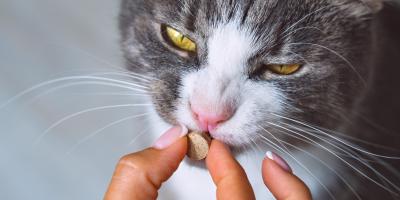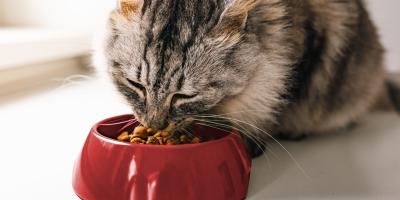Cat Seizures: Symptoms & Treatment


Cat seizures are symptoms of a range of conditions and often occur quite suddenly. It can be alarming the first time your cat has a seizure, but try to stay calm and remember the episode is temporary.
Keep reading to find out more about cat seizures and epilepsy, as well as tips for making the experience less stressful for you and your pet.
What Are Cat Seizures?
Cat seizures manifest as unusual behaviors such as collapse, twitching, gnashing of the teeth and tremors.
During a cat seizure, there are sudden, electrical impulses that disrupt the normal processes in the brain. This can result in nerve stimulation elsewhere in the body, resulting in twitching and other abnormal behaviors.
Seizures in cats are a sign of abnormal brain function and aren’t a disease in themselves.
However, seizures can also be caused by problems other than brain abnormalities. Kidney problems, liver disease or low sugar levels may also trigger them.
There are various categories of seizure. Often, an episode will be considered generalized or partial. A generalized seizure involves both halves of the brain, whereas a partial seizure is related to a specific brain region.
What is Cat Epilepsy?
Cat epilepsy is a condition characterized by seizures that happen repeatedly and are caused by disruptions in brain activity.
If your pet has experienced a single episode in their life, they are unlikely to be diagnosed with cat epilepsy.
Epilepsy in cats should not be confused with the genetic condition called idiopathic epilepsy, which usually affects both dogs and humans, but is a fairly rare illness in felines.
Idiopathic epilepsy in cats also manifests through seizures, but in this case, no abnormalities can be detected in the brain or anywhere else in the body.
Cat Seizure Symptoms
The symptoms of a cat seizure vary depending on the cause and type of episode.
General seizures typically have a sudden onset and last up to three minutes. They can be alarming to watch as you might see symptoms such as shaking, loss of consciousness, twitching or urination.
Compared with dogs, seizures in cats of all ages are more commonly partial rather than general. Depending on the affected region of the brain, the symptoms can vary significantly and may be very subtle.
The symptoms of a partial seizure in cats can include:
- Unusual movements
- Drooling
- Facial twitching
- Tail chasing
- Loud vocalizations
- Aggressive behavior
In certain cases, it can be difficult to distinguish the symptoms of cat seizure from other behavioral signs.
At times, an episode can go unnoticed because the signs are so slight. Keep an eye out for symptoms such as excessive thirst, tiredness or constant pacing, as these can precede a cat seizure.
If you suspect there is something unusual about your cat’s behavior, contact your veterinarian. If possible, make a quick note of the time that the seizure starts. If your cat’s seizure lasts for more than 5-10 minutes, it’s considered a medical emergency. Call your veterinarian immediately.
Also contact your veterinarian for advice if it’s your cat’s first seizure, they have not been treated for this problem before, or they have multiple seizure episodes close together, regardless of how long each episode lasts.
What Causes Epileptic Seizures in Cats?
Seizures in cats can be a symptom of many different health problems and the causes are often categorized as intracranial (within the brain) or extracranial (due to disease elsewhere in the body).
Examples of intracranial causes include brain inflammation, tumors and trauma. Extracranial causes can include the ingestion of toxins, kidney disease, liver disease, heart arrhythmias and disrupted blood sugar regulation, among others.
Compared to younger cats, older cats are more likely to have a concurrent health problem.
A seizure may otherwise be “idiopathic.” This is more commonly diagnosed in younger cats and the diagnosis is made when an underlying cause is not identified, and the seizure occurs because of a brain malfunction affecting neurotransmission.
What to Do if Your Cat is Having a Seizure
If you notice your cat starting to have seizure, here are a few things you can do to help them.
Keep an Eye on Time
Try to note how long the cat seizure lasts. Seizures vary from a few seconds up to 10 minutes or more– useful information for a veterinarian to know.
If your mobile phone is handy, you could start a stopwatch to help you with this. A seizure that hasn’t stopped after five minutes is cause for concern; call for emergency veterinary advice.
If the seizure stops after three minutes or less, book an appointment with your veterinarian, especially if this is the first time you’ve noticed seizures in your cat.
Reduce Stimulation
Turn off the lights, but make sure you can still see safely by leaving a lamp on or keeping the door ajar with a light on in an adjacent room.
Anything noisy such as a television or radio should be switched off, and anyone present should talk quietly and calmly, giving your cat plenty of space.
Don’t Move or Touch Your Cat
It’s tempting for a loving cat owner to want to help their pet during a seizure, but avoid touching them unless absolutely necessary.
However, if they’re in danger of hurting themselves by falling or hitting a hard surface, move your pet to a safer place. Make sure you use a blanket to avoid being bitten or scratched, as these behaviors are common during a seizure even in a pet that is normally docile.
Call Your Veterinarian if the Seizure Doesn’t Stop
A prolonged seizure lasting more than five minutes is cause for emergency care. Do the same if the seizures are frequent or if you notice your cat struggling to breathe.
Treatments for Seizures in Older Cats
The treatment and management plan for cat seizures will depend on the underlying cause of the seizure. Although idiopathic epilepsy is a quite common cause of epilepsy in cats, this is less likely in an older animal. The condition is generally diagnosed through a process of excluding other causes.
Your veterinarian will need to perform a thorough health check of the cat and recommend what diagnostic tests are necessary. This usually involves blood tests followed by an ultrasound or X-ray, or referral for advanced imaging depending on the findings.
Depending on the diagnosis, your veterinarian will recommend treatment options.
In some cases, the underlying cause of cat seizures cannot be cured but can be effectively managed.
Medication may be appropriate, and your veterinarian may suggest anti-convulsant drugs, either as a preventative option or for use if a prolonged seizure occurs.
Many of these treatments require long-term monitoring and check-ups. Unfortunately, one of the most common causes of seizures in older cats are brain tumors, which will require additional treatment.
Cat seizures can be alarming but try not to panic. With proper care, you can help protect your pet and keep them as comfortable as possible.
For more feline health tips, check out our cat health articles for advice from our experts.

Be Rewarded for Your Purina Purchases
Earn and redeem points for Purina products with myPurina app.




